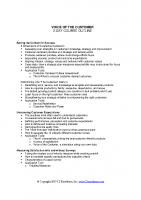Voice of the Customer Training
Uncover, Translate, Balance and Deliver what Customers Want
The Challenge
The notion that we should listen to “the voice of the customer” is well meaning, but an insult to our intelligence. Everyone knows there is no such thing as the customer. This necessarily means there must be more than one voice to listen to. Yet we can make potentially fatal assumptions about (1) who “the customers” really are, (2) what questions to ask, (3) how to prioritize their answers and (4) how to define and measure success. Traditional efforts such as used in product development, application of Six Sigma, ISO 9001 and related standards, VoC projects, Baldridge Criteria, HCAHPS, the Kano model and satisfaction surveys miss key questions every practitioner must answer.
You’d never tolerate multiple answers to the math problem, 7+5=X. We’ve had years of math training, but little or none in linguistics. The ambiguity of our language and weak linguistic discipline remains a largely untouched challenge. Consider the top auto executive who understood customers say they wanted more miles per tank of gas. Did this lead to (a) more efficient engines, (b) light weight materials, (c) innovative propulsion, (d) aerodynamic bodies or (e) bigger gas tanks? The executive’s design team rushed to market with bigger gas tanks. No kidding!
Our Voice of the Customer training shows how easy it is to confuse what you heard with what they said (not to mention what they wanted but didn’t say). Mistaking the literal voice of the customer with the untapped heart and mind of the customer is tragically common. This course supplies the needed rigor. You’ll see how both improvement and innovation opportunities become unavoidably obvious.
The firm that lost a $400 billion contract (that’s right, with a “b”), referenced in this presentation, is simply one more scenario of what can go wrong when interpreting customer priorities. On the other hand, examples from government, healthcare and such recognizable firms as Starbucks, Amazon.com, Southwest Airlines, Honda, Motorola and Google illustrate the growth potential possible by using the easy-to-understand but rigorous methodology described in this session.
Voice of the Customer Learning Objectives
Don’t even think about conducting a voice of the customer project, commissioning a customer survey or designing new services without the innovative framework and tools provided in this session. You’ll learn a refreshing new way to uncover and translate the mind of the customer in ways you never thought possible, including how to:
- Create the strategic framework for your VoC initiative
- Compare the 12 most common ways to collect customer needs (most of which fail)
- Avoid the ten most frequent failures of satisfaction surveys
- Determine who your customers really are in every context (both outside and within the enterprise)
- Use the unique “word formulas” that always uncover priorities
- Conduct a powerful, streamlined customer focus group session
- Translate squishy perceptions into design requirements, objective measures, and innovative alternatives
- Connect customer satisfaction, product design and growth
- Assure VOC deployment internally across functional silos
Educational units (REUs) are available for ASQ members
Voice of the Customer Training Takeaways include
- An easy to understand, step-by-step method for defining what your customers want
- An Excellence Framework that balances customer and enterprise values
- A jargon-free language that eliminates ambiguity
- Tools to (a) differentiate 3 roles a customer can play in any context, (b) discover whether the customers with most power have it appropriately, (c) identify the priorities that are/aren’t measured, (d) translate subjective perceptions into objective measures and design criteria
Voice of the Customer Training Agenda
- The practices most often used to understand customers
- Why surveys fail and the essential keys to success (how one saved $1 million)
- The four dimensions of excellence customers want satisfied
- The specific steps to uncover customer priorities
- “Word formulas” you didn’t learn in school, as powerful as mathematical equations
- How to distinguish performance, perception and outcome expectations and why it matters
- How to define service and knowledge work as concrete, tangible and measurable
- The three roles a customer can play (that marketing research usually misses), and which one to focus on
- Essential elements of a customer focus group
- How to translate fuzzy perceptions into objective performance measures
- Cases of how this methodology has resulted in better than 20-to-1 ROI
The length of the session determines the depth of material covered and the amount of hands-on application time.
- Live in-house workshops (customized to the client’s special objectives and circumstances): 1 to 3 days
- Public workshops: 1/2 to 3 days
- Executive seminars and dinner lectures: 90-120 minutes
- Interactive webinars: 2-4 hours
This 3.5-hour interactive webinar is a modified version of essential elements of the full-length workshop. It is designed to make your transformational efforts much easier, faster, and more impactful than anything you’ve seen or experienced. It is based on a brand-new way of thinking, new tools, and a proven track record of stunning results. It will benefit change leaders in all knowledge-intensive organizations.
Most executives and change leaders emphasize that customer satisfaction and excellent service are top priorities and keys to success. This session is all about how to achieve those goals with speed and simplicity. The answers use unconventional thinking to achieve outstanding results.
The magnitude of the challenge becomes clear when you ask any ten employees (a) what “service” means, (b) who “the customer” is or (c) what customers’ top priorities are. How can we have evidence-based enterprise direction when we aren’t clear who to get the evidence from or what to ask? We can fix this by using a new paradigm and pragmatic method for achieving unambiguous agreement on the answers to these essential questions. Your goals for understanding, measuring and satisfying customers are suddenly simplified and magic happens.
Who Should Attend
If you are impatient for transformative results and are an executive, change agent, product development manager, project leader, innovation leader, or Lean Six Sigma MBB, this jargon-free session is for you.
Objectives
In only 3.5 hours, you will learn how to:
- Create the strategic framework for your VOC initiative
- Compare the most common ways to collect customer needs
- Avoid the ten most frequent failures of satisfaction surveys
- Determine who your customers really are in every context
- Use “word formulas” that always uncover priorities
- Connect customer satisfaction, service improvement and growth
- Translate subjective VOC data into objective, actionable data to support your project
Takeways
- An easy to understand, logical method for defining what your customers want
- An Excellence Framework that balances customer and enterprise values
- A jargon-free language that eliminates ambiguity
- A clear roadmap for uncovering, translating and integrating voice of the customer with process, product development, innovation, measurement and demonstrable excellence
- The method to (a) differentiate 3 roles a customer can play in any context, (b) uncover customer priorities in any context, and (c) deploy the voice of the customer across silos
Agenda
8 Dimensions of Excellence framework
- Assessing your strengths on customer knowledge, strategy and improvement
- Customer-centered priorities at 4 strategic and tactical points
- Producer-centered priorities, where most change efforts focus
- Separating process, product and outcome expectations
- Aligning mission, strategy, values and behavior with customer values
Determining Who “The Customer” Really Is
- The fastest growing product category you could be in (but probably aren’t yet)
- Laser focus on the right customer: three customer roles
- Strengthening your strategic initiative by empowering the right customers
Uncovering Customer Expectations
- The practices most often used to understand customers
- 10 reasons why surveys fail and how to get success
- Defining performance, perception and outcome expectations
- How to define and balance competing interests
- Demographics we easily miss
- The “word formulas” that always uncover what customers want
- How to separate the 12 critically different customer voices
Steps to Success
- Examples of application in industry and government
- Selecting the right targets for application
- How to get maximum impact
- The Action Plan
A Few Practitioner Results
- 450% improvement in problem diagnosis related to customer calls
- Delinquent account collection of $1.21 million
- Recognition in a prestigious national team competition
- Changed airline practices, resulting in best-in-class satisfaction and luggage handling
- Increased revenue for a financial firm by $48 million in 6 months by changing how new customers were engaged
Sample Participant Comments
“We have considerably advanced our ability to satisfy customers, improve products and bring about sustainable change within our organization. I am pleased.”Herbert S., Executive Director, MSD
“The ability of Mr. Lawton to take a complex process and present it in segments that makes it easy to “digest” is amazing. My expectations were to walk away from this session with a tool; my expectations were exceeded because I also gained insight–the concepts were enlightening. The examples provided were excellent and helped in connecting the dots. Thank you.” Carolyn B., Outreach Coordinator, Rutland Regional Medical Center
Click here to REGISTER
(Prerequisite program – Strategy and Tools)
Educational units (REUs) are available for ASQ members
This class is definitely NOT for the faint-hearted! Mr. Lawton led us through an intensive, fast-paced presentation designed to reframe how we think about customer satisfaction and service. He encouraged each participant to continually challenge how we think about ‘products’ and our role in providing these to our real customers. He provided a very clear understanding of what a customer-centered culture is and how to create one.


